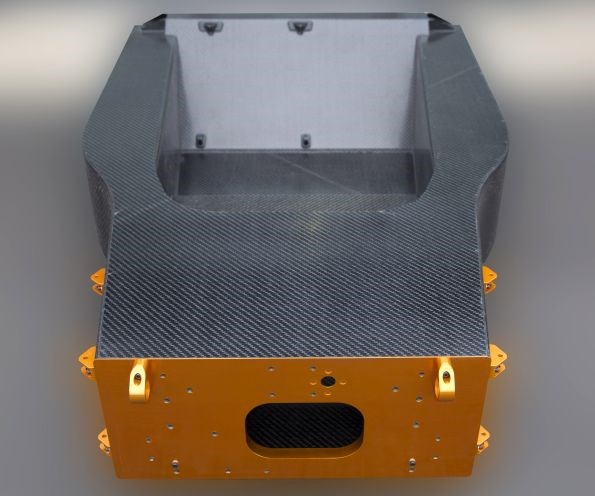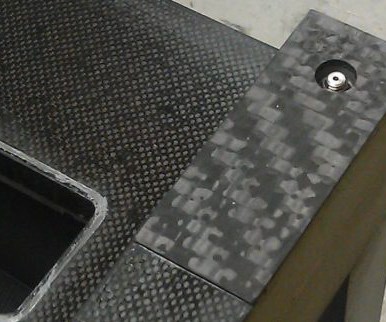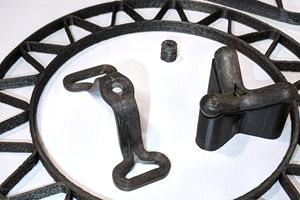Future automotive is collaborative, digital and smart using composites
According to Swedish startup Uniti, “The era of heavy, costly and unsustainable is coming to an end.”
The “Future is Built” ?
I recently listened to a Freakonomics podcast where CEO Jim Hackett discusses his future vision for the Ford Motor Co. Host Stephen Dubner points out that while Ford has mocked electric vehicle (EV) upstart Tesla in its recent “Built Ford Proud” campaign, Hackett is basically pegging Ford’s future on selling its customers’ data.
“Jim Hackett says Ford is eager to collaborate with the Silicon Valley heavyweights in order to get a piece of their pie. But one TV ad in a new campaign called “Built Ford Proud” opens by mocking Silicon Valley. “ — Stephen Dubner, Freakonomics Radio

Dubner presses Hackett to make the case for Ford vs. Tesla. Hackett responds:
“So the case I would make is that we have as much data in the future coming from vehicles, or from users in those vehicles, or from cities talking to those vehicles, as the other competitors ...”
“… we have 100 million people in vehicles today, that are sitting in Ford blue-oval vehicles. That’s the case for monetizing opportunity versus an upstart who maybe has … 120,000 or 200,000 vehicles in place now. Just compare the two stacks: which one would you like to have the data from?”
“We know what people make. How do we know that? It’s because they borrow money from us. And when you ask somebody what they make, we know where they work; we know if they’re married. We know how long they’ve lived in their house, because these are all on the credit applications. We’ve never ever been challenged on how we use that. And that’s the leverage we’ve got here with the data.”
Note that Hackett isn’t just talking about selling your credit application data, he’s also trying to develop tech that he can sell to Silicon Valley and others.
At the 2018 Consumer Electronics Show, Ford pitched its Transportation Mobility Cloud which will reportedly support the rapid development of services and apps to enable more efficient movement of people and smart, connected transportation. Ford has also hyped what it calls C-V2X, or Cellular Vehicle-to-Everything technology, which it says will allow a city’s various components and applications to share information with each other, from vehicle to pedestrians and bicyclists, to the whole infrastructure, enabling collision-avoidance safety systems, traffic signal prioritization, and much more.
Meanwhile, Ford will no longer build sedans but only trucks, SUVs and the Mustang, plus 16 EV models it has promised to unveil by 2022.


The Uniti One electric vehicle will exploit digital twin technology (top) and carbon fiber-reinforced thermoplastic composites (bottom) in its bid to redefine both automotive designs and production. SOURCE: Uniti and KW Special Projects.
The future is collaborative, digital, smart using composites
Today, however, I am watching the YouTube video from Swedish start-up Uniti (https://www.uniti.earth/). The juxtaposition with Ford could not be more dramatic.
“That was sort of the basis: make an electric car but make it make sense as an electric car. If you have a two-ton electric car with a ton-and-a-half battery, the battery’s primary job is to move itself around instead of moving the human around. We wanted to make electric cars that made more sense.” — Uniti CEO Lewis Horne
“The [Uniti] vehicle platform has been redesigned for modern usage patterns and the era of autonomous electric mobility. Our composite based vehicles boast a new approach to safety, sustainability, and scalability of manufacture, enabled by our foundation partnership with Siemens and others.”
— Uniti website“The reason we wanted to go with Siemens … is that whole digital back end [digital twin, production twin] that Siemens has is also connected to the energy grid globally, and roads and cities globally. It’s not just the data we create, it’s the net data created by humans that we get to be a part of.” — Uniti CEO Lewis Horne in the YouTube video “Digitalization helps Uniti make electric cars that make more sense”
The company’s first model, the two-seater Uniti One, was actualized using an organic, rapid-iteration design process and Siemens PLM software, including its NX generative design and digital twin platform as well as Simcenter, Teamcenter, Tecnomatix, MindSphere and Fibersim for composites. The “fail-fast” iterative process developed three working prototypes in four months using collective feedback on sketches, 3D printed models, CAD meshes and virtual reality experiences. The latter also involved thousands of potential customers to help evolve the car’s digital interface, which is based on a tablet PC, eliminating the traditional dashboard. The steering wheel has also been swapped for joystick controls.
“We never told them how to drive it or how to use it; we just wanted to see if it was intuitive and we built on the design from there.” — Lewis Horne, from Siemens case history

The design process also included digital manufacturing and virtual prototyping
of a serial production line using Tecnomatix. SOURCE: Siemens
Uniti is fully embracing digital twin technology, with a plan not only to have a digital twin for each vehicle on the road, but also for each production factory. The company will then use actual in-service data to make its vehicles better, depending on each one’s unique use and issues. Each digital twin can be used to track that physical vehicle’s issues back to its cause in parts production, design, etc. and suggest repair, parts replacement or other fix. That data is then input to improve future designs but also the production factories.
Thus, Uniti is pursuing not only smart, sensing vehicles connected by the Internet of Things, but also smart advanced manufacturing that continuously learns and improves based on its products’ performance in the real world. Siemens is working on this same concept with Airborne and SABIC for the realization of thermoplastic composite parts production on a massive scale.
First, however, Uniti is simply trialing different manufacturing options before it commits to equipment or facilities. “You can simulate the working factory first,” says Horne. “You can do all your cost modeling and confirm all the logistics before you actually spend millions building it. … And digitalization makes the whole process wildly more efficient.”
However, Uniti has committed to a location for its first factory — Silverstone Park, the historic Formula 1 racetrack and home to the British Grand Prix, now turned into an advanced manufacturing development hub. Partnerships with local companies such as KW Special Projects (composite chassis and additive manufacturing), Danecca (batteries) and Unipart (global supply chain logistics) undoubtedly helped. (Note that Williams Advanced Engineering has formed a joint venture with Unipart — Hyperbat Limited with a new factory (click on the home page’s Fly-through) — to produce batteries for EVs. Williams also unveiled its own carbon fiber chassis for EVs. The UK has not only formed a strategy to take leadership in global EV design and production, it has funded it as well, including the ToPCaT development below).
The 4.0 pilot plant at Silverstone — slated to be operational by 2020 — will produce the Uniti One and serve as a blueprint for globally licensed “digital” assembly plants worldwide.


KW Special Projects developed the carbon fiber-reinforced composite chassis that will be used for the Uniti One. SOURCE: KWSP
ToPCaT: ThermoPlastic Carbon Tub
Uniti’s partner KW Special Projects (KWSP) will provide the company’s choice for a chassis — the carbon fiber reinforced thermoplastic monocoque referred to as ToPCaT (ThermoPlastic Carbon Tub). Development of the technology started in 2015, aimed at a lightweight but lower-cost alternative to traditional autoclave-cured epoxy monocoques. Using thermoplastic composites enables much lower cycle times as well as recyclability, and ToPCaT claims to deliver high performance, low tooling costs and repeatable manufacturing with a modular construction for design and production flexibility.
According to a Composites in ManufacturingJuly 2017 article in magazine, KWSP managing director Kieron Salter said he foresees big changes in materials over the next 10 years. Though he favors composites, he predicts vehicles will use more hybrid materials produced by additive manufacturing processes, including materials that can heal themselves, change shape to suit their environment and provide structural health monitoring/diagnostics. “One can see that the automotive sector is very much at a tipping point,” he says. “Over the next 10 years, it may be that we are about to see as much change as we have witnessed in the last century.”
Developed technologies reflect the mission
Though Uniti and KWSP are open to metals, hybrids and new materials that may be developed in the future, they have embraced carbon fiber composites as a key part of their mission because they deliver the lightweight, performance and cost key to making their electric vehicle designs work.
Uniti describes digitalization as being part of its DNA. This also generates value and performance, enabling a team of 15-20 people to complete a base design and three working prototypes in record time. I see Uniti as going even further than Tesla in its involvement and relationship with its customer base, using digital communications, as it proves market value through pre-orders and updates its crowdfunding investors.
Uniti milestones and future goals
- 2016 – Uniti founded in Sweden
- 2017 — Vehicle prototype revealed
- Crowdfunded development
- Cultivation of a community through social media and digital messaging
- 2018 — First preorders online and via two MediaMarkt stories in Sweden (2,500 orders)
- 2018 — Unveiled at India’s Auto Expo a virtual reality demonstrator of a 5-seater model to be produced with Delhi-based Bird Group
- End of 2019 — Production Intent Model to be revealed
- 2020 — Fully digitalized, i4.0 production site in UK operational
- 2020 — 5-seater model in production in India
- Expansion into northern Europe, US and Asia Pacific
- 2024 — Achieve at least 4% of Europe’s battery EV (BEV) market
Uniti does discuss development of its own vehicle-to-vehicle (V2V) and vehicle-to-infrastructure (V2I) capabilities — so, the same realm of capabilities as Ford’s C-V2X and Transportation Mobility Cloud. But Uniti’s efforts are a sidenote, framed as just one of its innovation areas and with the motive to help its vehicle customers by improving safe city driving, for example, or offering new ways to securely make parking transactions.
Is all of this too good to be true? Perhaps. I think the reality is that Uniti’s vehicles are a niche market, aimed at dense urban areas where congestion and pollution are real issues that need to be addressed now. But the trends that Uniti is demonstrating regarding generative design, virtual testing of prototypes, digital twins and simulation of manufacturing processes along with production lines comprised of smart, flexible manufacturing cells — that is the future of automotive and beyond.
Related Content
TU Munich develops cuboidal conformable tanks using carbon fiber composites for increased hydrogen storage
Flat tank enabling standard platform for BEV and FCEV uses thermoplastic and thermoset composites, overwrapped skeleton design in pursuit of 25% more H2 storage.
Read MoreDrawing design cues from nature: Designing for biomimetic composites, Part 1
Biomimicry is an interdisciplinary methodology that can inform composites design and manufacturing via use of more effective and sustainable materials, structural fabrication and technological practices.
Read MoreHigh-performance, high-detail continuous 3D-printed carbon fiber parts
Since 2014, Mantis Composites has built its customer and R&D capabilities specifically toward design, printing and postprocessing of highly engineered aerospace and defense parts.
Read MoreThe next evolution in AFP
Automated fiber placement develops into more compact, flexible, modular and digitized systems with multi-material and process capabilities.
Read MoreRead Next
Composites end markets: Energy (2024)
Composites are used widely in oil/gas, wind and other renewable energy applications. Despite market challenges, growth potential and innovation for composites continue.
Read MoreFrom the CW Archives: The tale of the thermoplastic cryotank
In 2006, guest columnist Bob Hartunian related the story of his efforts two decades prior, while at McDonnell Douglas, to develop a thermoplastic composite crytank for hydrogen storage. He learned a lot of lessons.
Read MoreCW’s 2024 Top Shops survey offers new approach to benchmarking
Respondents that complete the survey by April 30, 2024, have the chance to be recognized as an honoree.
Read More









.jpg;maxWidth=300;quality=90)













